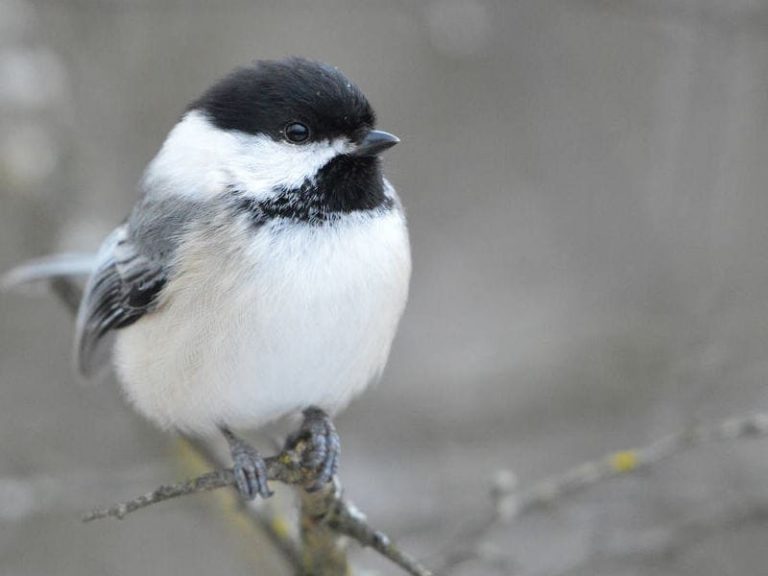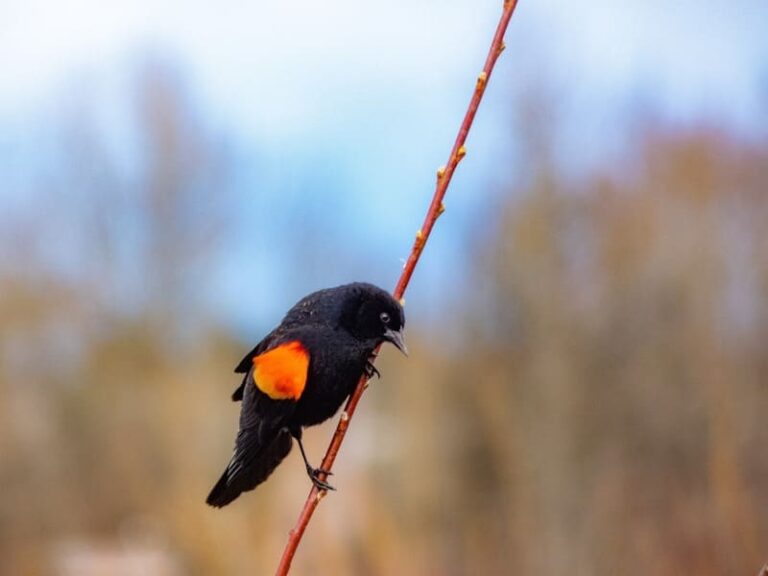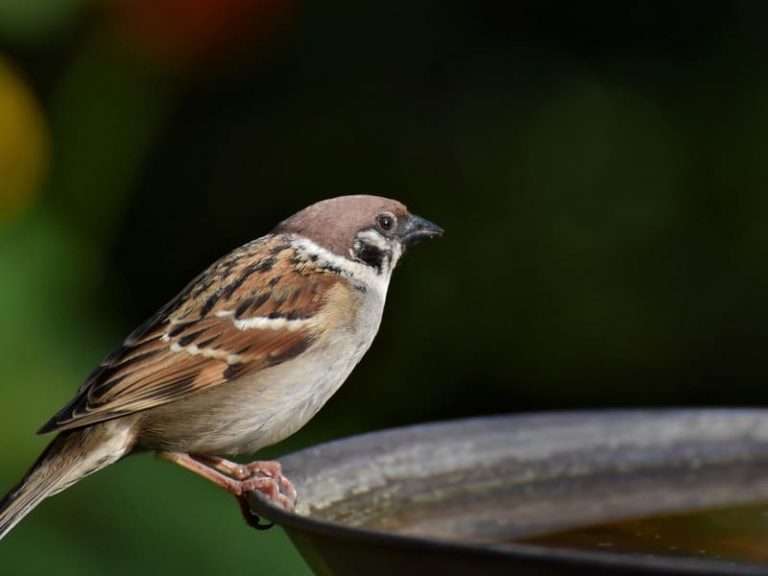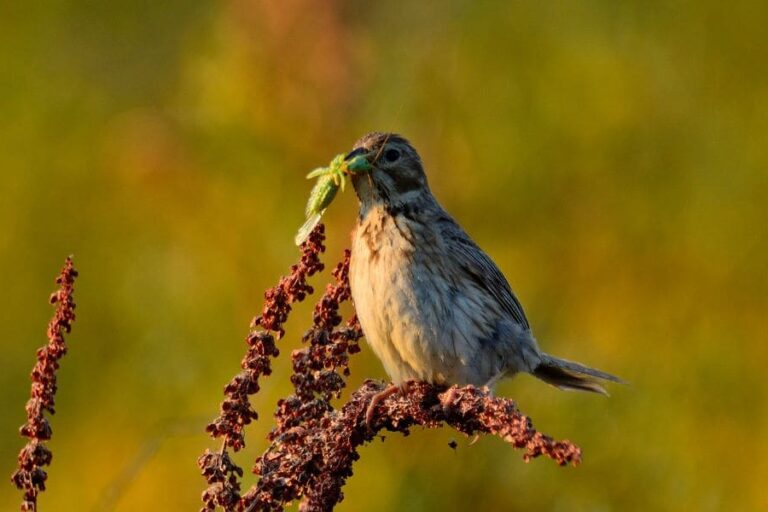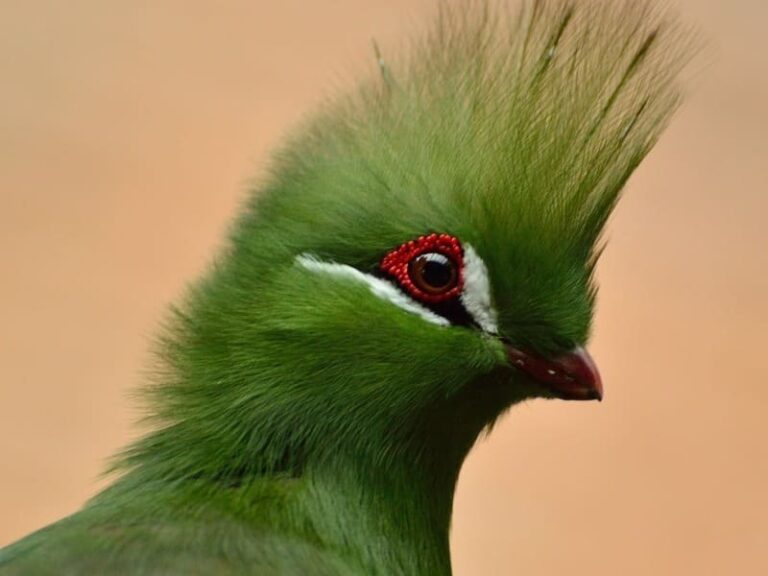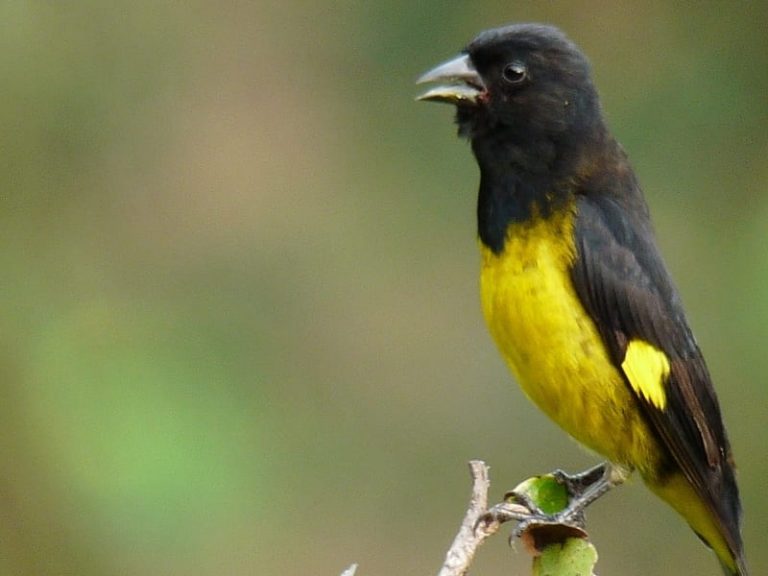11 Green And Yellow Bird (With Pictures)
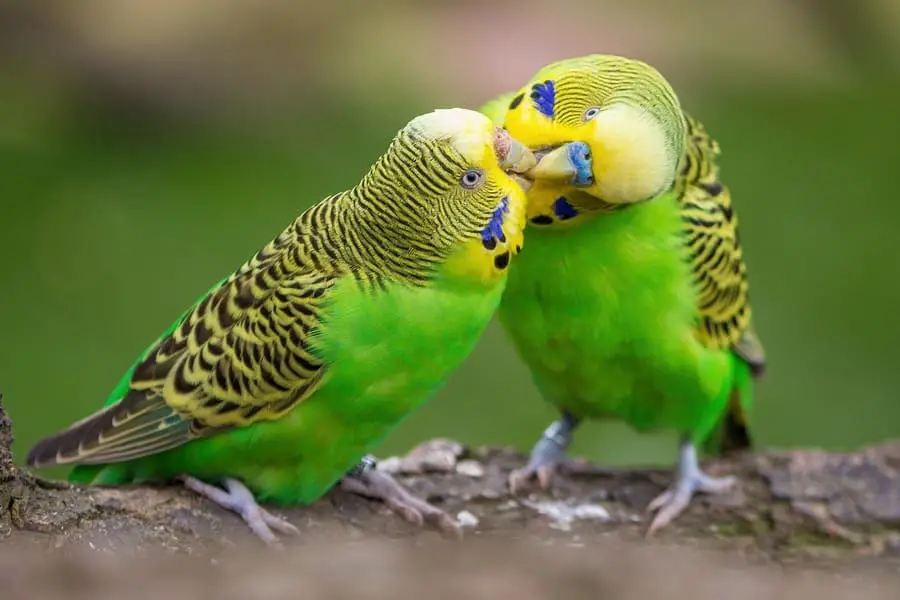
With a colourful and vibrant palette of feathers, it’s no wonder that a green and yellow bird has long been a favourite among birders.
Whether you’re an experienced birder or looking to add some beautiful avian specimens to your backyard feeder, these striking feathered friends are sure to bring delight and curiosity into your life!
From playful cardinals to woodpeckers that never stop chipping away at the trees, there are plenty of species flitting about the great outdoors that display these two hues in harmony.
In this article, we will explore 11 popular varieties of green and yellow birds from around the world and look at their distinct features.
With advice on how best to attract them and expert tips for identifying them in their natural environment, you can be sure of discovering something new each time you venture out with binoculars in hand.
Green And Yellow Birds
Flashing in and out of the sky, green and yellow birds are beautiful additions to any outdoor scene. Though often hard to spot, with a keen eye, one can sometimes find these winsome creatures flitting about, looking for food or building nests with bits and pieces of nature’s scraps.
Their cheerful chirps provide a pleasant sound as they traverse from one tree to the next, bringing happiness to those who take notice.
The simple beauty of these striking birds is something that captivates many people and draws them closer to nature and all its wonders.
These unique feathery creatures have a variety of characteristics that make them distinct. For one thing, they often have dark eyes and beaks in comparison to the rest of their body. They also call attention to themselves with cheery chirps, which can put people in a good mood instantly.
Additionally, unlike other species with similar plumage, they tend to have relatively short wingspan, allowing them greater agility when cutting through the air.
Because of these appealing traits and others like them, green and yellow birds are sure to draw admiration from all who witness them up close.
1. Budgerigar
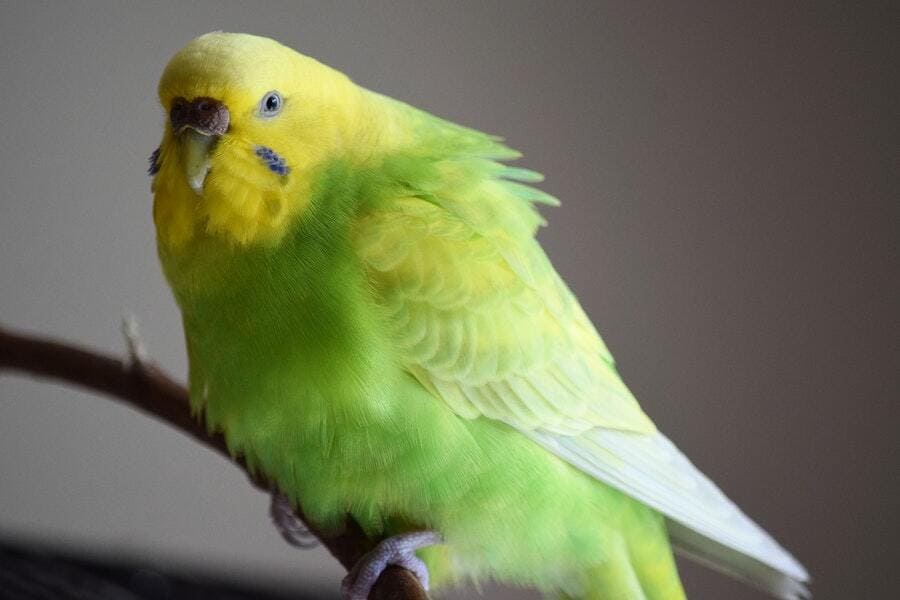
- Scientific name: Melopsittacus undulatus
- Lifespan: 3-6 years
- Wingspan: 12 inches
The budgerigar, commonly known as the “budgie”, is a small, sociable bird found in Australia. It has become popular as a household pet due to its playful and affectionate nature.
It is an excellent choice for those who are seeking a calm and gentle companion bird that enjoys interacting with people.
Budgies come in many beautiful colours, such as blue, yellow and green, making it easy to find the perfect feathered friend for your home.
They typically live between 5-10 years, depending on their care and environment, so expect to commit to providing a loving home for your buddy for many years! Some important information about budgerigar:
2. Hooded Warbler
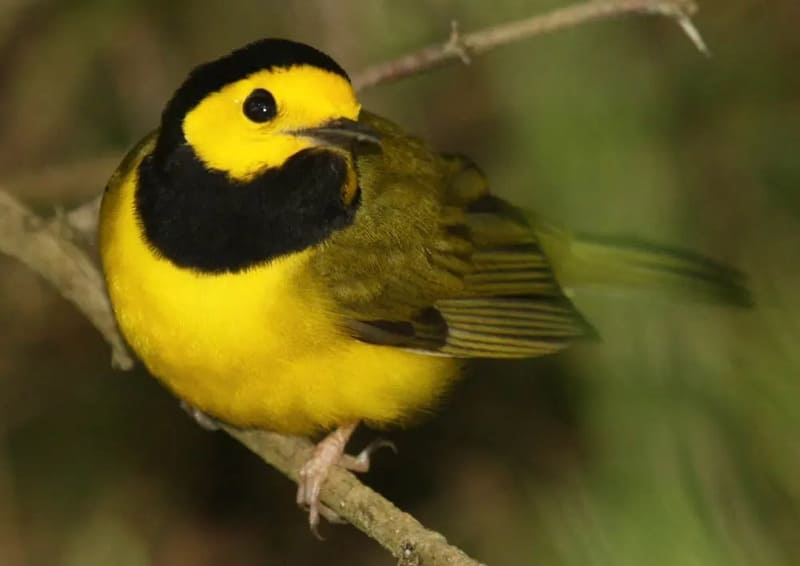
- Scientific name: Setophaga citrina
- Lifespan: 8 years
- Wingspan: 6.9 inches
The Hooded Warbler is a medium-sized songbird which is surprisingly more common than it may appear. These birds are found mainly in eastern North America, breeding from southern Canada to the Gulf Coast of Texas. It prefers wet woodland areas and overgrown fields, especially near streams and rivers.
Its distinctive loud warble often draws attention in deciduous forests where it can be spotted searching low branches for insects such as caterpillars, small moths, and grasshoppers.
The Hooded Warbler also loves to feast on wild cherries and blackberries during the summer months.
During the winter season, Hooded Warblers migrate south to Central America to spend time near tropical forests or other dense vegetation areas.
With its colourful yellow head feathers and white undersides, this species of bird, first identified in 1833, still has much admiration amongst ornithologists today due to its unique colouration and affinity for beetle larvae. Important information about hooded warbler is:
3. Lesser Goldfinch
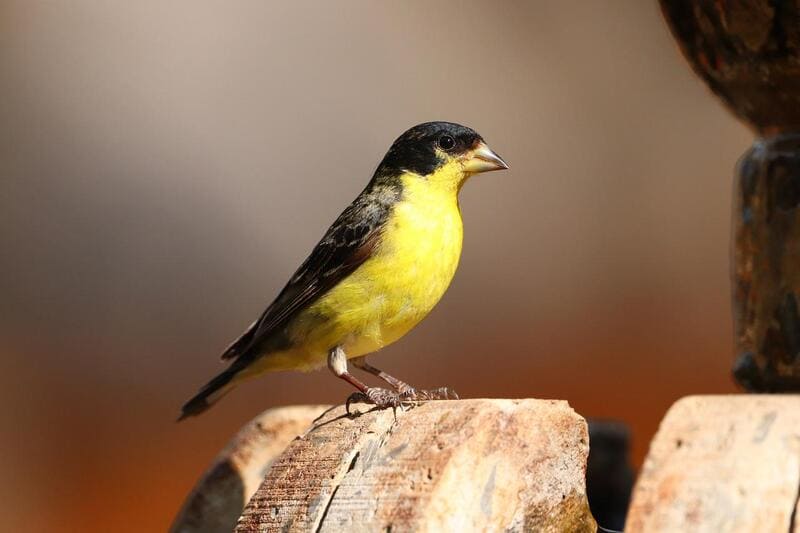
- Scientific name: Spinus psaltria
- Lifespan: up to 6 years
- Wingspan: 8 inches
The Lesser Goldfinch is a small bird that thrives across the United States and parts of Mexico. They typically have yellow bodies with subtle variations depending on location, like black wings or a black cap or both. Male Lesser Goldfinches sing to attract female companions with their sharp and pleasing songs.
Often, they move in groups to feed on grass seeds, insects, and other small animals throughout the trees and shrubs they call home.
Their colourful feathers are also perfect concealment against predators while they search for food on the ground.
Being such dynamic creatures, adapting to different environmental conditions, they can usually be seen throughout all times of the year.
Because of their beauty and lively personality, the Lesser Goldfinch makes an interesting addition to any backyard! Important information about Lesser goldfinch is:
4. Golden Conure
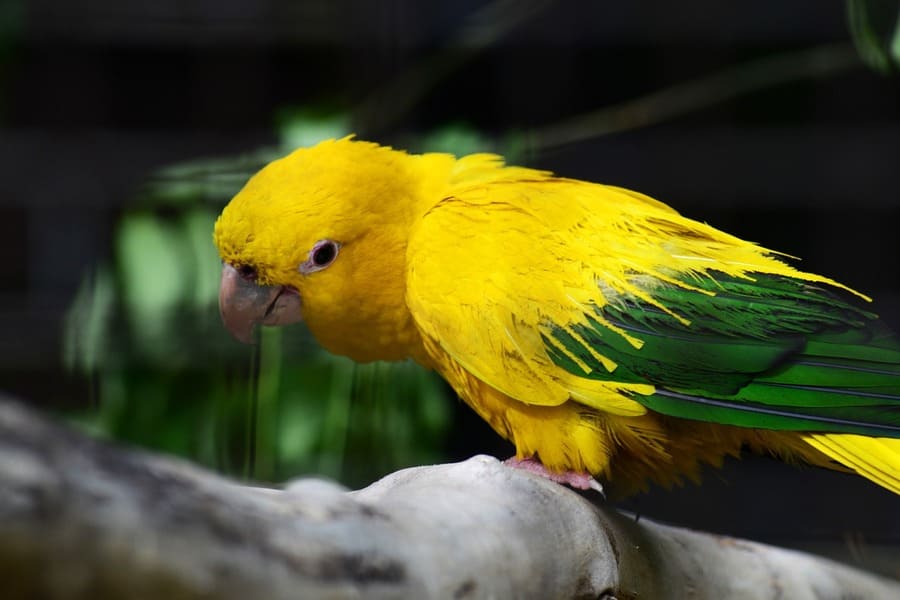
- Scientific name: Guaruba guarouba
- Lifespan: 20-30 years
- Wingspan: 8.3 inches
The Golden Conure is a type of parrot that is native to South America, particularly Brazil. It is known for its bright yellow feathers and distinct call that helps it stand out amongst other types of birds.
These beautiful creatures inhabit tropical forests from the Caribbean coast to the Amazon River basin.
They form large flocks in their natural environment, with each flock containing anywhere between 30 and 500 conures depending on the area.
While they mainly live on fruits, berries, and nuts, they are also known to feed on insects and seeds found on the ground from time to time.
The Golden Conure has been observed building nests mostly in termites mounds or tree holes and laying 2-4 eggs per clutch.
This type of parrot can make an entertaining pet provided they are given plenty of attention and mental stimulation through various activities such as playing with toys or talking to their owners. Important information about golden conure is:
5. Blue-naped Chlorophonia
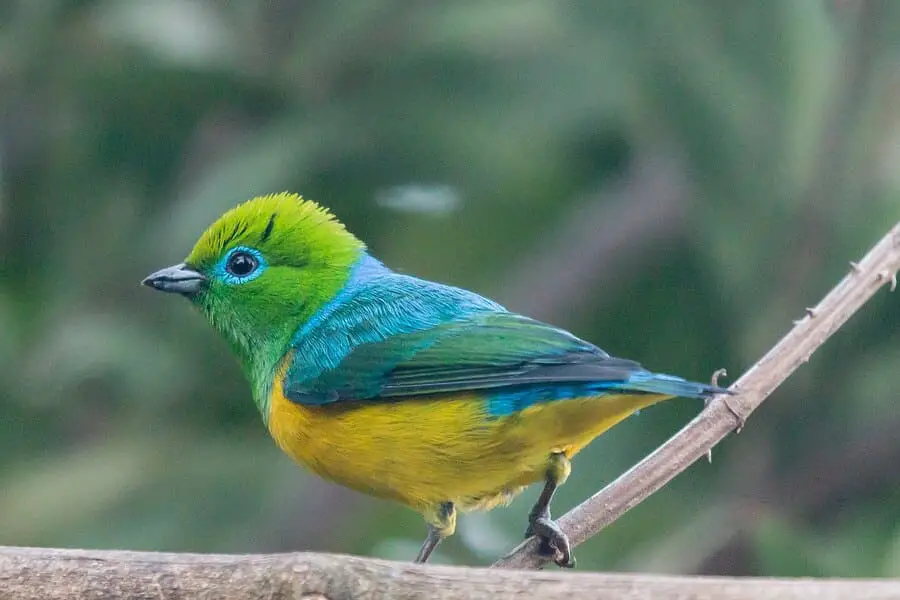
- Scientific name: Chlorophonia cyanea
- Lifespan: n/a
- Wingspan: n/a
The Blue-naped Chlorophonia is a very striking species of bird native to Central America. It’s unmistakable in appearance due to its bright blue head with a black stripe running down the centre and its vibrant yellow breasts.
This attractive songbird is most commonly found in the understory of tropical forests and often joins mixed-species bird flocks.
The Blue-naped Chlorophonia diet consists mostly of fruits, berries and seeds, supplemented by insects when available.
Like other members of its family, it utilises a dynamic type of singing known as ‘variable strophes’, in which whistled phrases are repeated multiple times before switching to another phrase or stopping completely.
Because the majority of the Blue-naped Chlorophonia habitat is being lost due to deforestation, this species has been recognized as Near Threatened by the International Union for Conservation of Nature. Important information about Blue-naped Chlorophonia
6. Great-tit
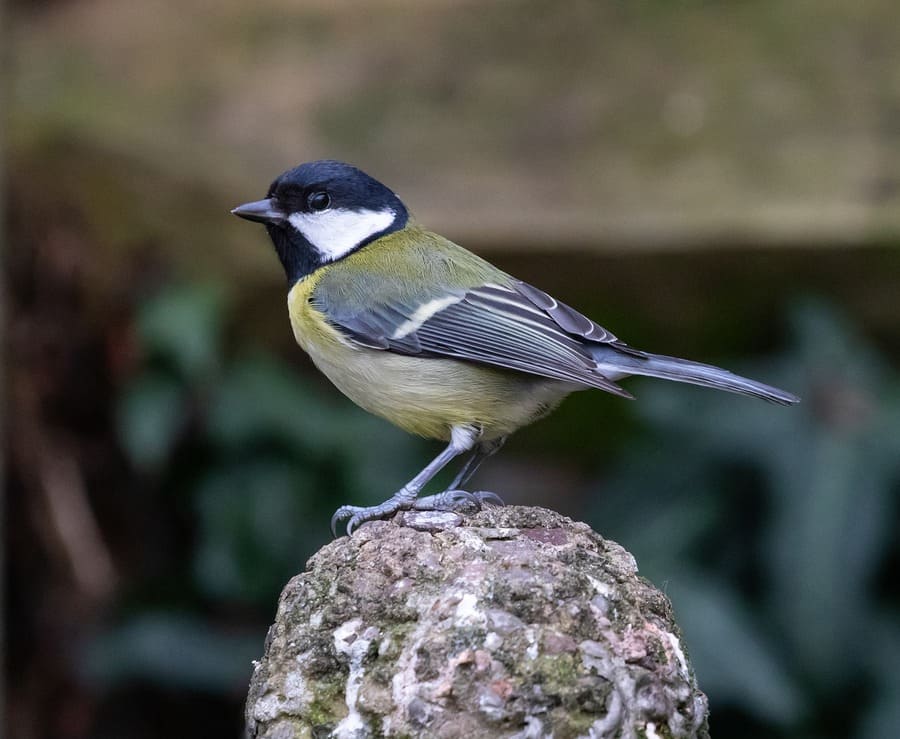
- Scientific name: Parus major
- Lifespan: 3 years
- Wingspan: 9.5 inches
The Great-tit is a common passerine bird that actually belongs to the titmouse family. These small birds are commonly found in gardens and parks across Europe, as well as parts of North Africa and Central Asia.
They can easily be identified by their bright yellow breast, blue heads with white cheeks, greenish backs and tail, and two white bars on their wings. When it comes to their diet, they enjoy eating seeds, fruit, and insects.
They are also known for being particularly agile when hopping from branch to branch or searching amongst leaf litter for food.
Unfortunately, due to the increasing development of natural habitats such as forests, these birds have become increasingly less common in some areas of the world over recent years. Important information about great tit is:
7. Painted Bunting
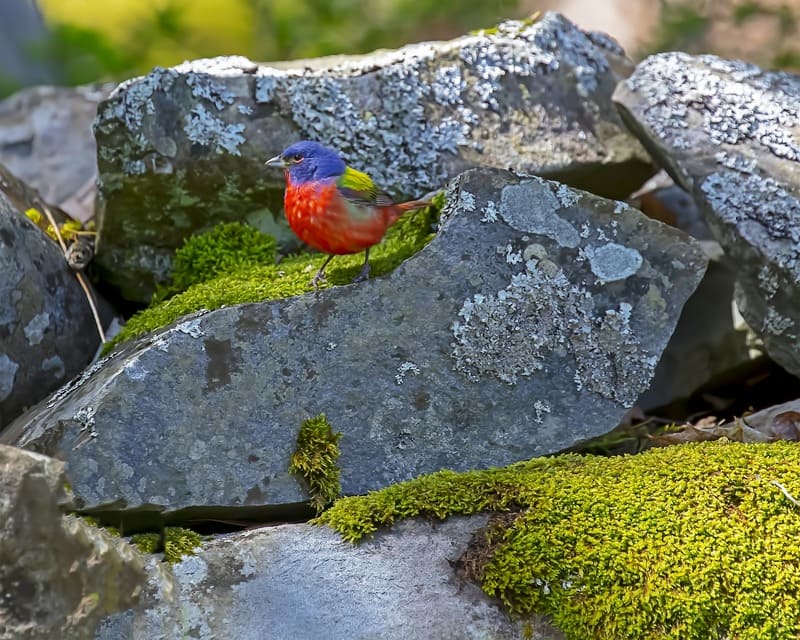
- Scientific name: Passerina ciris
- Lifespan: 5-10 years
- Wingspan: 8-9 inches
The Painted Bunting is an exotic bird that can be found in many parts of the United States and Mexico. Its vibrant colours make it a striking addition to any scenery, and its distinctive song is easily recognizable.
While the male is best known for its bright blue head and greenback, the female is duller, with shades of olive green on her wings and tail.
The Painted Bunting loves open fields for foraging, wet areas such as marshes or creeks for nesting, and woody areas where it can sing from atop branches.
They usually breed once a year during the summertime and can lay up to four eggs at a time. Its worldwide population is considered steady, though there have been reports of some endangerment due to changes in their habitats as well as illegal trapping.
To ensure this species’ survival, organizations are promoting conservation and education about these birds so that we can keep admiring them around the world. Important information on painted bunting is:
8. Wilson’s Warbler
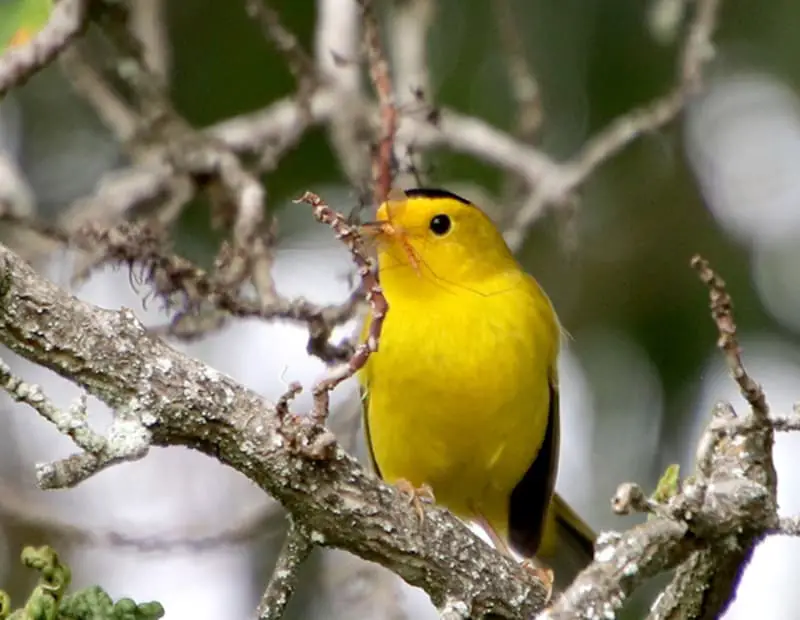
- Scientific name: Cardellina pusilla
- Lifespan: 6 years
- Wingspan: 5.5–6.7 inches
Wilson’s Warbler is a small yellow-tinged songbird native to North America and parts of Central America. It is recognizable for its bright yellow head and distinct white spot on its ear coverts.
Wilson’s Warbler forages for food in thick foliage, primarily feeding on insects, spiders, and caterpillars. These birds are popular with birders due to how active they are during the summer months. Nesting typically occurs close to the ground in dense shrubbery or low trees near water sources.
Their population has unfortunately been declining over the past several years due to reduced habitat, making them vulnerable to extinction without human intervention.
Conservation efforts need to be continued. Their numbers can rebound sustainably before it’s too late. Important information about Wilson’s warbler is:
9. Yellow-naped Amazon
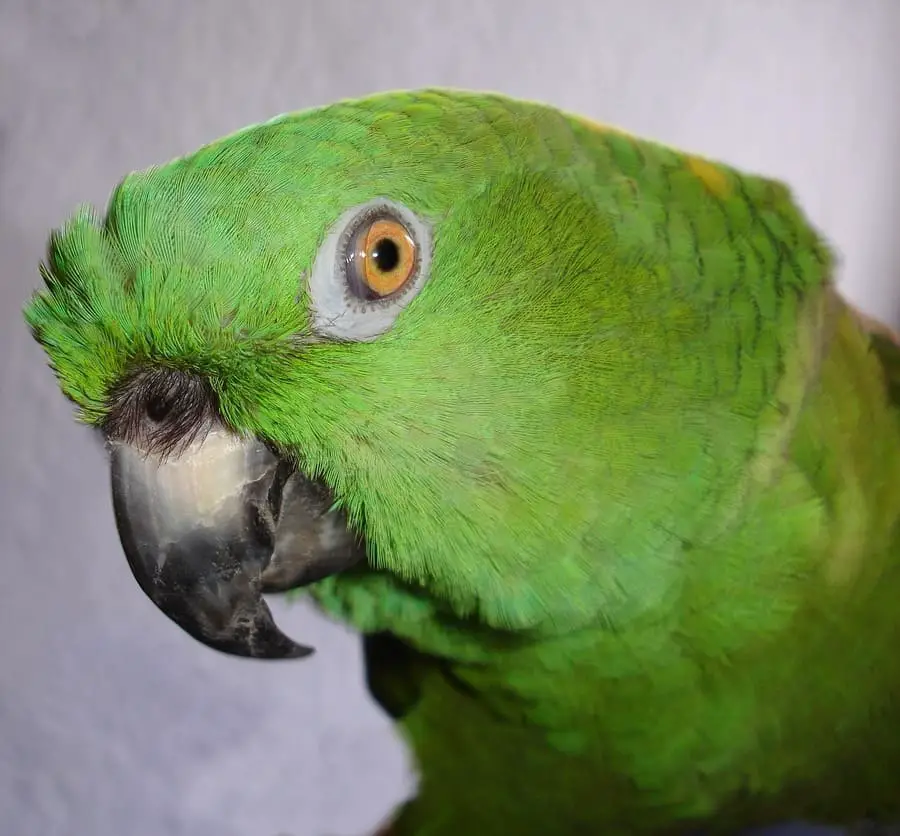
- Scientific name: Amazona auropalliata
- Lifespan: 20-30 years in the wild
- Wingspan: 8-8.5 inches
The Yellow-naped Amazon is an exotic and rare parrot native to Mexico and Central America.
This species of parrot has a distinct yellow patch on its head and a bright green body with yellow lines along its wings. The feathers of the species are sparse, leading to the shimmery effect when in flight.
It has blue tail feathers, a maroon forehead, and prominent eyes. Unfortunately, this beautiful bird is endangered due to the loss of habitat due to deforestation and illegal trapping for the pet trade.
Conservation efforts have been put in place, which includes educational programs teaching local citizens about how to preserve their local habitats.
Increased awareness amongst communities may hold the key to preserving these birds for generations to come. Important information about yellow-naped amazon is:
10. Green Jay
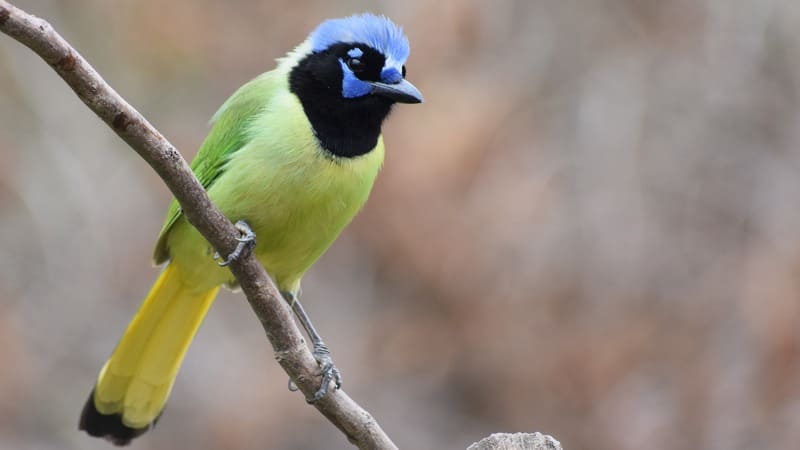
- Scientific name: Cyanocorax yncas
- Lifespan: 10-11 years
- Wingspan: 13.5-15 inches
The Green Jay is a beautiful and intelligent bird native to the Southwestern United States in addition to parts of Central and Northern Mexico.
As their name implies, the Green Jay comes decked out in bright green feathers that are accented by streaks of black, white, and yellow.
With piercing blue eyes and a large beak equipped for cracking nuts, they make stunning additions to any outdoor space.
Notably, Green Jays are one of few birds with relatively complex communication abilities; they possess an ability to memorize feeding spots, allowing them to return years later, even after being displaced.
One particular trait that stands out about the Green Jay is its unique vocalization: it doesn’t sing like other birds but instead produces sharp, metallic noises.
It also isn’t a shy bird; when it encounters people, it actually advertises its presence by calling loudly and often approaching humans when nearby.
Its remarkable diet consists of a variety of items, from insects to fruits and seeds. All in all, the Green Jay is an incredible creature with many fascinating characteristics that make it stand out from other birds. Important information about green jay is:
11. European Greenfinch
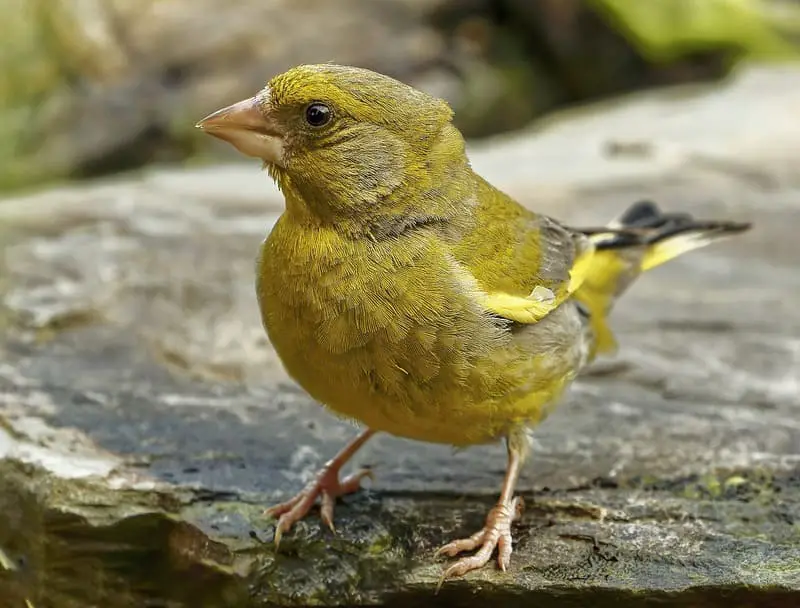
- Scientific name: Chloris chloris
- Lifespan: 2-3 years
- Wingspan: 9.6-10.8 inches
The European Greenfinch also called the Green Linnet, is a colourful and delightful songbird found in Europe. These birds boast lovely yellow and green feathers, with males having a brighter red patch than females.
They usually live in open areas but can occasionally be spotted in woods and orchards looking for food, such as seeds and insects.
The European Greenfinch has an impressive vocal range that consists of a range of whistles and warbles on many different notes.
It is also known to sing duets with other birds, exhibiting an unusual behaviour seldom seen among birds. The intonation of the song can often reveal if they are excited or scared which makes them even more fascinating. Important information about European greenfinch is:
Final Words
It’s not always easy being green, but these 11 amazing green and yellow birds are proof that it can be done!
These beautiful creatures range in colour from bright lime to deep olive, with accents of yellow, gold, and even orange. Some are vibrantly colourful, while others are more subdued.
But one thing they all have in common is that they’re sure to add a touch of beauty to any bird-watching expedition.
So keep your eyes peeled the next time you’re out looking for feathered friends; you might just spot one of these stunning specimens.
You will also enjoy reading:

